Bigger and saucier than ever, Reykjavik’s fringe artists return to the stage.
´Tis the season for strip teases, stand up comedy, drag queens, and a little bit of circus; Reykjavik Fringe is back! Opening today, Saturday, July 3rd, Reykjavik Fringe Festival promises to be the biggest exhibition of arts and culture since before the plague. Or wait, is the plague over?
Now that Iceland’s pandemic restrictions have been completely lifted (minus the border), the first thing on everyone’s mind is getting back on stage and into an audience. After all, we didn’t drudge through those vaccine side effects for nothing.
The Fringe Festival this year promises to be bigger and badder than ever despite the logistical nightmare of planning over 70 acts in dozens of venues across town. GayIceland sat down with Nanna Gunnars, the director of the festival, to chat about what to expect from this year’s festival and to find out who exactly will be doing a strip tease this year.
On the Fringes of Art
Sitting on a few borrowed antique sofas Nanna chats with Storm Dunder, Olivia Finnegan, and Danilo Nava. Storm Dunder is a non-binary performer from Sweden that live-streamed into the 2020 festival. Olivia is an American producing the festival this year. Danilo is the bi immigrant and one third of the Identity Crisis stand up comedy trio. Among a few laughs, they all say Reykjavik Fringe is the best place for up and coming artists to get noticed and for the boundaries of art to be tested.
“People that feel in some way at the edges or an outcast or something find a home here,” says Nanna. Not every show at Fringe is about sexuality though. Nanna also says it’s about the other uncomfortable things that maybe mainstream art overlooks. “[Fringe art] is also like the show on invisible disabilities. We have other acts about disorders and overcoming those. There’s a lot of artists telling stories about reaching the fringes of society,” she says. “Stjohn, who’s from New Zealand but lives in Hungary, has a show at Mengi about time in prison. And it’s an experience to say the least. I can’t tell you much more but people get angry with him, some people will get upset by the show but it’s great and experimental.”
“It’s gonna be loud, it’s gonna be raucous, it’s gonna be like: “let the tits free on the stage!””
Another experimental act at this year’s festival is a concert for sheep. Yep, you heard that right. Sauðatónar, or Sheep Music, is a performance by three artists who tried to determine what music sheeps liked best by traveling to various farms and playing for them. The President of Iceland, Guðni Th. Jóhannesson, is even slated to attend the event at Árbæjarrsafn today.
The event description says “Sheep Music is a contemporary realization in concert form of the old Icelandic kvöldvaka, long evening wakes where families would gather in a room to entertain themselves and nurture a sense of community through storytelling and wool crafts. Real sheep will assist the musicians, while the audience members are very welcome to bring along their instruments for knitting and spinning while listening.”
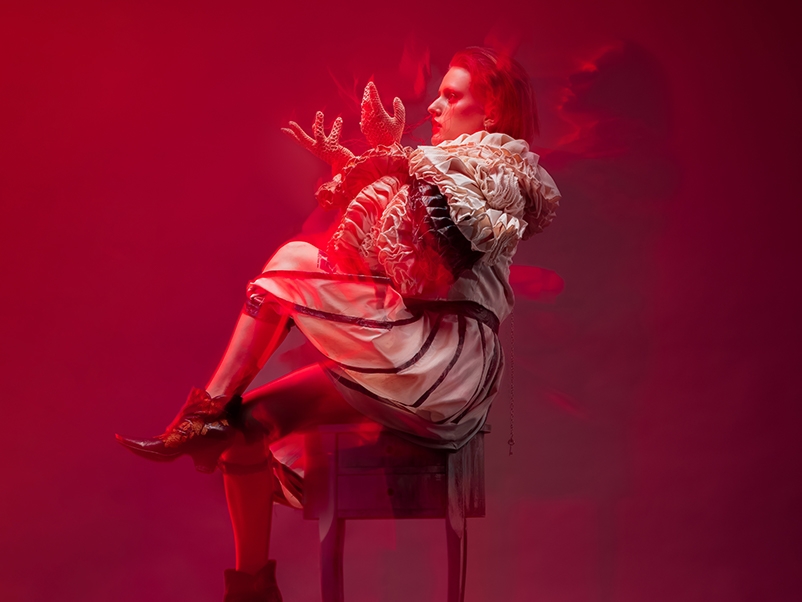
Feeling Human Emotion Again
Other shows include Storm Dunder’s The Clown on the 5th Floor, which won the festival’s Grand Prix award last year. Storm says they didn’t even show the full performance last year and it was only through live stream, so this year’s full length performance on stage and in person should be even better. “It was just a sneak peak into the show, so I’m very happy it got such a good response.”
When asked how they ended up performing at Reykjavik Fringe, Storm says: “I was at the Stockholm Fringe Festival, where I was premiering my show and was awarded the Nordic Fringe Network award. Nanna saw my show there. She told me: “You have to apply to the Reykjavik Fringe.” I had always wanted to come here because I love the cold. I feel like I can breathe when it’s cold. The world is also, like, on fire, so where should I go?” they laugh.
Storm tried to perform from their bedroom in Sweden last year, but that didn’t go so well when it came to the awards ceremony. “When the award ceremony was happening Nanna messaged me and I was like at home, in my living room, wearing sweatpants. Then I heard I won and Nanna asked for me to join in on the stream and I was like trying to do it on my phone, running around like “where’s my computer?” in a big rush and I couldn’t figure it out so I actually couldn’t even say thank you for it,” says Storm.
“I recorded and produced the entire show The Clown on the 5th Floor by myself in my bedroom.”
Getting back in front of a live human audience is what attracts Storm the most. “On the live stream there was a chat with people liking and the heart reactions. It’s nice, but I want to see not only the happy emotions but also sadness and tears,” Storm says. For them, it’s about more than just a thumbs up emoji, and you can’t quite tell when a digital audience is feeling contemplative, melancholy, or empathetic. “When you’re on stage you can see the full scope of emotions on people’s faces and in their body language, and that disappears when you can’t see them.”
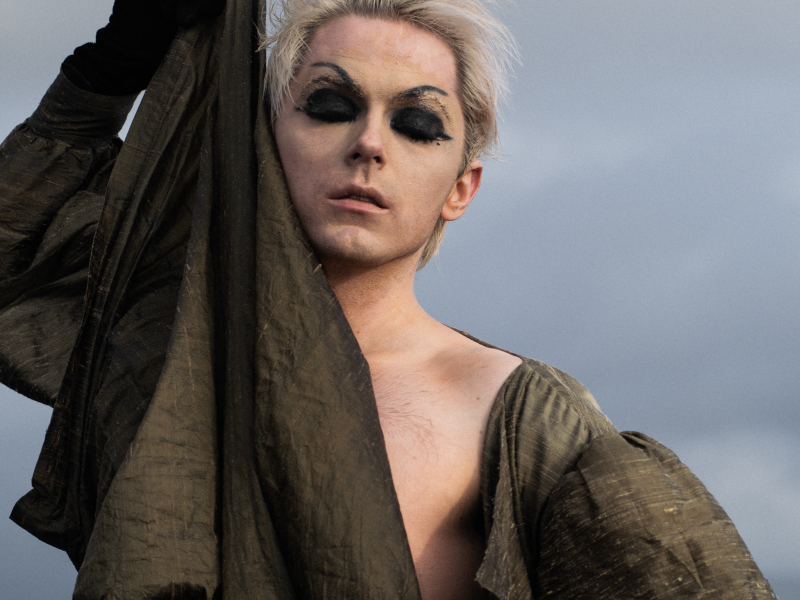
For this non-binary clown, these types of performances allow an audience to relate to things like trauma. “My show deals with very heavy subjects. It’s essentially about post traumatic stress disorder, so of course if people connect to what I sing about to their own lives then that is so much more valuable to me,” says Storm. The show description puts it best: “The Clown on the Fifth Floor tells the story of a creature that just wants to know if they were the hero, the villain, or just a child.”
Most importantly, Reykjavik Fringe is an opportunity for artists to release all their pent up creative energy. Without stages and audiences for over a year, many artists turned inward. That process wasn’t pretty for everyone, but some amazing things came out of it. “All of my free time for most of my life has gone into making art,” says Storm. “Not having a stage to perform that art that I was constantly working on was very, very strange. I did feel like the way that I handle life was just taken away. The stage to me was like the place where I process my emotions. I had an outlet for my thoughts and feelings and experiences and all of that was just gone. I kind of felt like a ticking time bomb, like I had to get this out in some way and I din’t know how,” they elaborate.
Inside now Outside
For Storm and many other artists, creating art amid the pandemic took a lot of ingenuity. “I mean I’m from Sweden; we basically went like “pandemic? What? It’ll be fine.” So there was a long period of time where nothing in my life changed basically. It wasn’t until April of 2020 when my job closed down and I was still in school. Classes were moved onto zoom but we weren’t locked down, you could walk out to the stores and restaurants in Sweden,” they say.
“So what I did was I just dove straight into making my solo show as an album. I learned how to produce music and I built a DIY studio in my bedroom and I recorded and produced the entire show The Clown on the 5th Floor by myself in my bedroom. I was trying to figure out creative ways to make a small space feel interesting. When you make a music video for a song that’s four minutes long, it has to change because otherwise the person who’s watching is not going to continue watching. But I only had this little corner. So what I did was I bought tubs of wall paint and painted everything I could find. A bedside table. Some frames. A piece of wood. I just piled these things onto one another. I had a plexiglass and I filmed into it and filmed reflections and tried to make the visuals move without actually moving anything physically because I was just sitting in a corner,” says Storm.
“What I love about fringe is the diversity of performance. I can be a bit fixed on comedy so this is a great chance to broaden my horizons for a week.”
With little room to create much, Storm says it was very reminiscent of Bo Burnham’s special Inside. “It’s basically my bed, a piano, and this empty corner and the bathroom. So I was like what can you do with that, trying to figure out different ways to create interesting art,” they say.
Those moments of frustration and exhaustion are real. “Bo Burnham’s Inside is a show about making a show. If he would have not included all of these pieces of him lying on the floor, talking into the camera like “I hate this,” “I feel like shit,” then it would have been a normal show. But because he included all of these things, it becomes about the process of making it. I have definitely done those things. Like in full clown costume, makeup, camera running, collapsed on the floor like “fuck this shit”.”
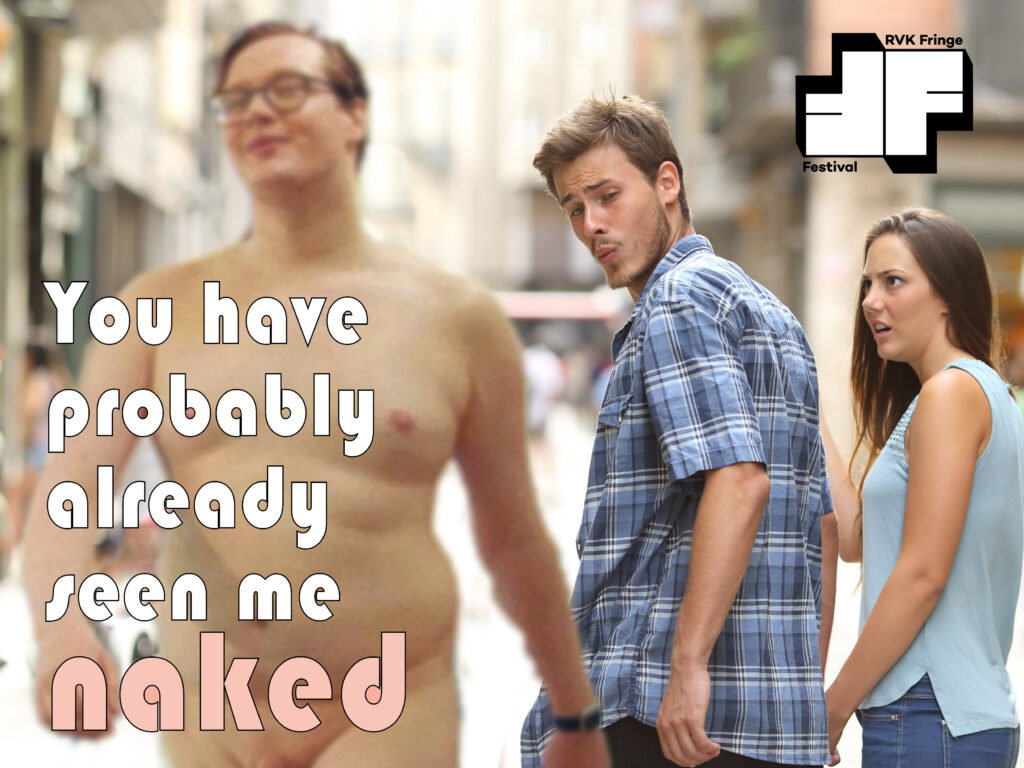
On How It All Began
Nanna says Reykjavik Fringe started as a stolen idea. “I hijacked the idea for Fringe from a guy called Jón Magnus, who was going to run it in 2017,” she says. “Jón is a poetry slammer and wanted to do this with a bunch of his creative friends. They weren’t quite sure about it and got in touch with the Nordic Fringe Network. Adam from Stockholm Fringe encouraged them a lot like, saying: “This is a great idea! You should go for it!” But they weren’t quite ready,” says Nanna. The group, although full of artists, just didn’t have much funding. “Jón ended up being alone with over 800 applications and it was kind of a fiasco. I was one of the acts that got accepted to that festival, because I’m an actress as well (flaunts hair), so I thought: “Why don’t I just run it”,” she says.
Fringe festivals aren’t anything new internationally, but it’s still a relatively new concept for Iceland. Nanna says this is changing and the word Fringe is getting more recognition now. People are starting to understand what this kind of art festival is all about. “Edinburgh Fringe is the largest art festival in the world and people in Iceland are kinda starting to know the word Fringe now because of Ari Eldjárn’s success,” she says. “He’s been to both the Edinburgh Fringe and the one in Melbourne.”
Ari, who landed a Netflix special all of Iceland was excited about, got noticed by an agent at one of his first shows at Edinburgh Fringe. Then there’s comedians like Kimi Tayler, self described as “Iceland’s premier D-List Celesbian stand-up comedian” who’s hoping this year’s festival will put more performances from Iceland on the map. “What I love about fringe is the diversity of performance. I can be a bit fixed on comedy so this is a great chance to broaden my horizons for a week,” says Kimi.
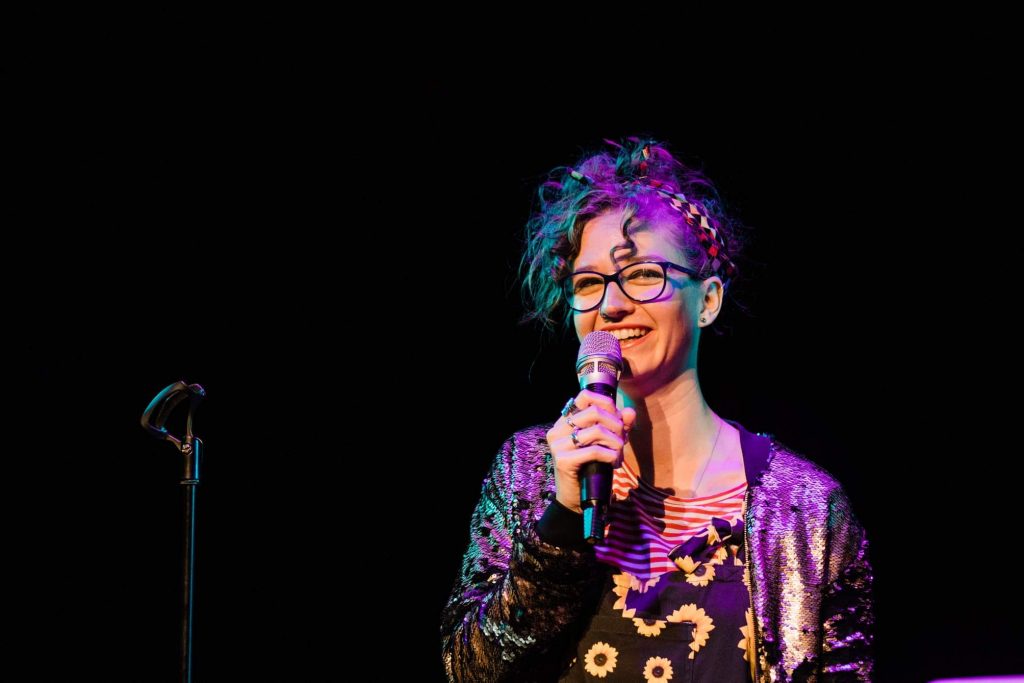
Blanket Fort Meets Stage
Kimi’s show at the Secret Cellar, W.W.K.D. (What Would Kimi Do), promises to “unpack her nostalgia for the 90s.” Always silly, always honest, this time Kimi will take her audience on a heady thematic journey of subjects from deep diving into her fondness of boy bands to considering her past career goals as well as touching on lighter subjects such as mental health, repressed memories and religion.
Kimi is another performer itching to get back on stage more than a fish trying to get back in the water. “I’m both excited and terrified to get back on stage,” she says. “But I’m confident that I’ve put together something cohesive, personal and hopefully funny! Me and my blanket fort are about as ready as we can be,” she says and laughs. There will be an actual blanket fort, don’t let the tagline fool you. This act was tested a few times at Kimi’s Lofty Ambitions Comedy Nights with other Fringe comedians like Arnór Daði. Arnór is following up a triple award win at last year’s festival with his new show That’s Weird.
Danilo Nava, a Venezuelan immigrant living in Iceland and fresh face on the comedy scene, will be performing a show called Identity Crisis. “Fringe gives artists the opportunity to get stuff out there that might not be perfect, that’s the best part,” he says.
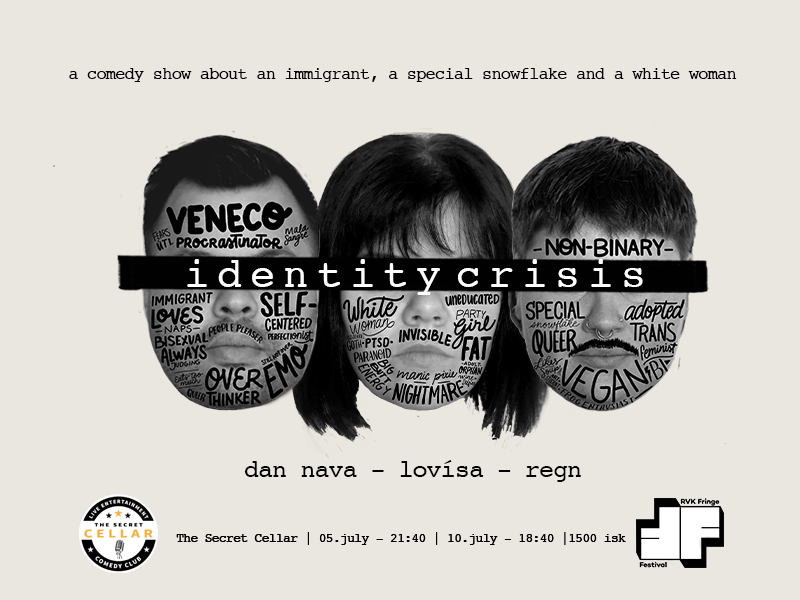
His show is slated to be a “pick-and-mix comedy show of 3 comedians that are literally going through it. The show is about the lives of an immigrant, a special snowflake, and a white woman.” Together Dan, Regn, and Lovísa plan to “unpack immigration, gender, sexuality, and mental health (or lack thereof).”
Regn is the first “vegan, non-binary, bisexual, bipolar, art student comedian” in Iceland. Lovísa is “a frustrated retail worker who uses comedy to blow off steam.” This threeway of comedy will be dissecting and reconstructing the labels all put on them by society through comedy.
More Than Stand Up
Fringe is not all stand up comedy. Nanna says there’s artists exhibiting all around town including “two painting exhibitions at Aðalstræti 2 and an artist making a mural on hotel Leifur Erikson.” Gógó Starr will be running a stage presence workshop for teens. “It’s not about drag,” says Nanna, “but it’s a drag queen walking you through how to be on stage if you’ve never done that, ya know?”
Kimi Tayler mentions bringing in acts other than comedy is great for the art scene in Iceland. “I am so excited to see some of the international acts. It’s always a breath of fresh air to get some new people performing, especially after the last year. The scene [in Reykjavik] is so small I think it does us all good to see some other faces!”
Even if you’re not into abstract expressions of sexuality or interpretive dance, Fringe is great for people that just love cats. “There’s a comedy show called Pure Evil: A One Man Show About My Cat from Koschka Bahrm,” says Kimi. “I know nothing about it but it’s about cats so I’m there!”
“I am so excited to see some of the international acts. It’s always a breath of fresh air to get some new people performing!”
At the end of the day, there’s so much going on at the festival it’s best to wander around venues and see what you walk into. “It’s so fun to play fringe bingo and pick a bunch of stuff that you have no idea what to expect,” says Kimi as she plans out her schedule of performances.
A Labor of Love
Reykjavik Fringe is far from a capitalist money grab. True to the roots of the festival and the artists on the fringe performing, Nanna says the whole thing is a labor of love. “We’re all volunteering. Everyone mixes it in after school or work and everyone with children or multiple partners and putting all that together.”
Just getting the festival off the ground this year has been a wild ride for Nanna. “I started organizing [this year’s festival] in April. We had a festival last year as well, in July, right in that window of like hardly any restrictions in Iceland except the international artists were live streamed. So we’re happy to have them here live this year, now we get to see them in a physical setting. A few of the performers coming are ones that live streamed last year,” she says.

Like all good things in Iceland, Fringe was originally thrown together last minute. “We’re kind of used to doing [Rvk Fringe] in a rush because the first festival we did in 2018, the first idea to even have it was in March and we did it in July. So we’re kinda used to doing it fast. Very Icelandic. I had the idea in March like: “Maybe I’ll run the Fringe festival”. And I told this to my partner and he was like: “Oh, like next year, right?” I was like: “I was thinking July,” and he was like: “Yeah, July next year.” And I was like: “No, this July, like in four months”.” She laughs.
Volunteers like Olivia Finnegan keep the wheels of the festival turning, whether that means unloading a car, hanging posters, or running to the bakery to pick up some donated pastries for the performers and crew. Oliva was meant to be at 2020 Fringe, but the pandemic had other plans. “This is the first time I’ll be boots on the ground in Iceland for the festival while I’m on the production team because last year I got kicked out of the country and was told: “You have no business here.” Which was crazy. I flew out of London exactly a year ago today and was due to arrive in Keflavik July 1st which just so happened to be the day that the US was re-added to Iceland’s travel ban list.”
Olivia says she “got all the way to the airport, got the nasal swab, and tested negative but was detained in the airport and told quote: “You have no business here” and put on the same aircraft, same crew back to London.” Although bummed, she says it’s good to be back. Originally Olivia came from the US in 2018 to perform her show American Single (like the plastic cheese slices). Basically the show was Olivia “coercing men that I met on Tinder to date [her] on stage.” Kind of ironically, she ended up in a relationship because of her show. “The show was a lot of fun,” she says but “the relationship wasn’t successful. I do credit the show for brewing the exact circumstances that I wanted to pursue it though.” She chuckles.
All in all, Olivia thinks Reykjavik is just a warmer and inviting place for her work. Surprising to many of the cold hearted locals, her style warmed them up. “When I was doing workshops with American Single in New York, the reaction was just so different from the reaction when I came here. I just felt welcome here and like the audience was going to be on board with whatever crazy thing I came up with. I felt like I could continue to let the show grow. Then once the show no longer had a place in my life, I didn’t want the festival to not have a place in my life so I posted on Facebook asking to work on Fringe,” she says.

Tickets, Tickets, Tickets
All Reykjavik Fringe events are open to attendees with wristbands. Some art you can see just walking around town. You’ll most likely be able to hear a few cabaret shows boasting loud vocals out onto the streets. “Cabaret shows at Bar Ananas,” says Nanna sweaty tent, “it’s gonna be loud, it’s gonna be raucous, it’s gonna be like: “let the tits free on the stage!””
The best way to get your access to these acts is by buying one of the super affordable Reykjavik Fringe wristbands for 1.000 ISK. Wristbands can be purchased through tix.is or at the door of one of the events.
The Reykjavik Fringe website has the full schedule of 2021 shows and events including tonight’s over the top Opening Party at the newly renovated art and culture space Mal og Menning. There’s also an app for all the tech savvy millennials. No ticket printing required.


